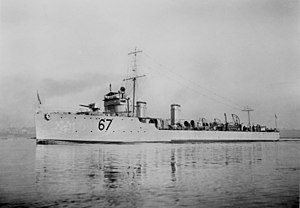 HMAS Torrens
| |
| Class overview | |
|---|---|
| Name | River-class torpedo-boat destroyer |
| Operators | |
| In commission | 1910–1930 |
| Completed | 6 |
| General characteristics | |
| Type | Torpedo-boat destroyer |
| Displacement | 750 tons |
| Length |
|
| Beam | 24 ft 3.75 in (7.4105 m) |
| Draught | 8 ft 6 in (2.59 m) |
| Propulsion | 3 x Yarrow boilers, Parsons turbines, 10,000 hp (7,500 kW), 3 shafts |
| Speed | 26 knots (48 km/h; 30 mph) |
| Range | 2,690 nautical miles (4,980 km; 3,100 mi) at 11.5 knots (21.3 km/h; 13.2 mph) |
| Complement | 66–73 |
| Armament | |
The River class was a class of six torpedo-boat destroyers operated by the Royal Australian Navy (RAN). The design was based on a modified version of the British River-class destroyer, 13 of which were planned under the 1904 Naval Estimates, but were cancelled before orders were placed.[1] The first batch of three ships was ordered for the Commonwealth Naval Forces in 1909, followed later by a second batch of three a few years later. All six vessels are named after Australian rivers.
The Rivers saw service during World War I. Ships of the class participated in the Australian Naval and Military Expeditionary Force capture of German New Guinea, and performed patrols in Australian and Malayan waters. In 1917, the class was deployed as a single unit to the Mediterranean, and assigned to anti-submarine patrols of the Adriatic. The destroyers returned to Australia in 1919, and were placed in reserve.
All six ships of the class were disposed of by the 1930s. Three were sold for use as accommodation hulks (two to the NSW Penal Department, the third to Cockatoo Island Dockyard) and later sank. The other three were sunk as target ships. The bow and stern sections of HMAS Parramatta were recovered in 1973 and are preserved as memorials.
- ^ Friedman, British Destroyers, p. 96